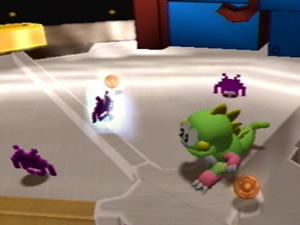A random act of vandalism.
Give a kid a paintbrush and you’ve got a big mess on your hands. Make that a magical paintbrush, though, and you’ve got Graffiti Kingdom, the story of a boy, his box dog companion and a quest to capture the devil that he unwittingly unleashed. You’ve also got a weird, interesting RPG thingamabob that succeeds almost as often as it fails.
It seems young Prince Pixel has stumbled onto an ancient secret known as the Graffiti Wand, which was used by ancient “Graffiticians” to battle demonic forces. Now Pixel must use the wand to gain the three keys to the devil’s fortress, defeat him and save the good people of the land from slavery. Hackneyed story? You bet. But thanks to an extension of the painting concept first seen in the quirky PS2 cult game Magic Pengel, Graffiti Kingdom is more artsy than it sounds.
The basics, though, are as basic as they come. Pixel runs around from small area to small area, smacking around any of the monsters he comes across with button-mashing attacks. The bad guys disappear and leave behind collectable experience medals, life-ups and devil cards, and then the process starts all over again. This pacing lasts for the entire game. There are a few bosses thrown in to shake things up, but even the big nasties are just glorified versions of the little guys in the field.
Luckily, Graffiti Kingdom puts a twist on this boring approach by letting you paint your way to success. Similar to Magic Pengel, this game allows players to draw their own 3D characters and use them in combat. But where combat in Pengel was the slow, turn-based stuff of RPGs, Graffiti Kingdom has you mashing buttons like a crack-addicted rat.
 You might even get a little bit high creating various fighting blobs with the simple painting tools. Players start by drawing a two dimensional shape, which is then transformed into six 3D interpretations. After choosing the one you like, you can draw in some arms and/or legs and presto – you’re Dr. Frankenstein. You can give it colors, different attack moves and even a voice.
You might even get a little bit high creating various fighting blobs with the simple painting tools. Players start by drawing a two dimensional shape, which is then transformed into six 3D interpretations. After choosing the one you like, you can draw in some arms and/or legs and presto – you’re Dr. Frankenstein. You can give it colors, different attack moves and even a voice.
Progressing through the game will net even more important options for your creations. Spinning, floating and charging parts become available as Pixel levels up. New fighting moves can also be found and added to your creature’s repertoire. The concept at work is a good one, and the simple, intuitive design tool works well.
If only the actual game part worked as well. In the end, it’s a lot more fun to draw the beasties than it is to play with them.
At least you don’t have to play with the same beastie all the time. For instance, successfully using the “capture” attack against a foe will allow you to transform into it for a limited amount of time.
There are also randomly dropped devil cards, which function like a cross between Pokemon and Yu Gi Oh. Up to three of these cards can be tied to buttons on the D-pad, allowing Pixel to transform into the chosen creatures quickly and easily. Each of these creatures has special abilities, such as power attacks or elemental blasts, and some can jump super high or run fast. But none of this matters as much as it should since every creature can punch, shoot or stomp anything you come across. If you’ve been one monster, you’ve been “em all.
 Besides Story mode, Graffiti Kingdom offers a simple Vs. mode that allows players to pit their beasts against CPU or human-controlled opponents in a numbing battle of the thumbs. We know how gamers, like rams, like to challenge their peers to contests of thumb strength and agility, but instead of matching digits in a furiously boring match of Graffiti Kingdom, we recommend an old-school game of Thumb Wrestling – it’s portable and you’ll never want a refund.
Besides Story mode, Graffiti Kingdom offers a simple Vs. mode that allows players to pit their beasts against CPU or human-controlled opponents in a numbing battle of the thumbs. We know how gamers, like rams, like to challenge their peers to contests of thumb strength and agility, but instead of matching digits in a furiously boring match of Graffiti Kingdom, we recommend an old-school game of Thumb Wrestling – it’s portable and you’ll never want a refund.
To its credit, looking at Graffiti Kingdom is definitely more interesting than staring at your own hands thanks to its kiddy art style with thick lines and basic textures. It’s no technical marvel, but you have to be impressed with the fluidity of the creature creator. Both the monsters and the environments are as colorful as a kid’s toybox, establishing a pretty inoffensive – if incredibly immature – theme. Thumbs up-ish.
All but the deafest gamers will take offense to the sound, though. The majority of the game (especially the menu) is riddled with annoying sound effects. When coupled with the happy-go-lucky soundtrack, it turns into an unsettling, clownish cacophony.
We’d like to give credit to Graffiti Kingdom‘s designers for sticking with a daring concept, but then they went and surrounded it with a mindless action shell. Overly repetitive, simplistic gameplay dominates the landscape, and only the monster creator saves this game from running out of ink completely.
-
Cool creation tools
-
Card collecting
-
Overly simple gameplay
-
Repetitive button-mashing
-
Annoying effects











